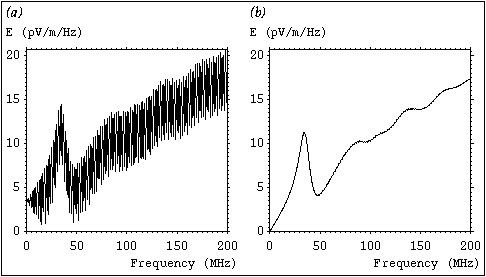
This data was obtained from a damped screened room simulation in which the output was taken coincident with an impulsive excitation. The output takes large positive and negative values on alternate timesteps, which do not decay with time despite the presence of losses in the system. This phenomenon is often observed near to an impulse excitation. The frequency of the oscillation is much greater than the maximum working frequency of the mesh (and is therefore of no interest) and it decays within the space of a few nodes. However, in the frequency domain, the required signal is hidden. The effect of a 50 point single-sided linear window is shown below, both without (a) and with (b) the window.

The effect described above can be attributed to the presence of spurious modes in the TLM mesh. However, for this example, this only impacts upon the signal processing requirement, and does not affect the final result. [IMHO, there is not currently a sufficient body of evidence to suggest that spurious modes are a real problem in most pratical simulations.]
In cases where the output field takes large positive and negative values on alternate timesteps, an alternative to a window function is to use a 2-point moving average filter.
From: "Developments in the Transmission-Line Modelling Method for Electromagnetic Compatibility Studies", Ph.D. thesis, University of Nottingham, J L Herring, May 1993.